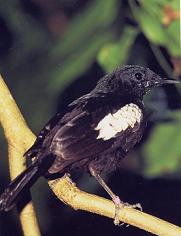Parents of endangered birds traced |28 November 2005

Three of the scientists said this during a presentation they made to their local counterparts at the Nature Seychelles Environment and Education Centre at Roche Caiman last week.
They also outlined several factors found to threaten the birds' population growth and survival during the process of relocation to other islands.
Frantic efforts to encourage the breeding of Magpie Robins started in 1998 when it was discovered that only 22 individual birds existed worldwide.
They were all found on Fregate Island, and the new measures were aimed at introducing colonies on Cousin, Cousine and Aride islands.
Each of the birds was then distinctly identified by rings fixed to their legs as have others that have been hatched since.
The family trees were established by two doctor of philosophy students from Finland, Andres Lopez Sepulcre of the University of Helsinki and Hanna Kokko of the University of Jyvaskyla who are working under the supervision of Professor Ken Norris of the University of Reading.
They demonstrated how using a computer chart that they have established, it is possible to trace a particular bird down to its last offspring.
"From this chart you can see that every bird and its parents are known by number and you can tell which is the oldest and the most productive," Sepulcre said.
He said they have also established what social settings are suitable for the multiplication or even survival of the birds.
"Every male or female is dedicated to a particular partner and they are closely linked to their offspring," he said, adding that every couple hatches about two eggs annually.
"A direct offspring seems to help in the feeding and caring of 'children' which definitely boosts the species numbers, but when there is a subordinate which migrates into a family it becomes a member but does not help," he said.
He said such immigrants are often involved in fights with the dominant adults as a result of which overall mortality increases.
Professor Norris said that initial efforts to create colonies on other islands besides the four named earlier that are free from predators like rats were hampered by slow adaptation where the birds failed to forage properly even where cockroaches, their preferred food, were available.
"It turned out that the birds needed to be supported with 'artificial food' like boiled eggs and shells," he said.
He said that the kind of monitoring being done for the Magpies with the precise particulars of each bird being well documented is new and can be used around the world with other species of birds, giving the ongoing project global relevance.
The chief executive officer of Nature Seychelles, Nirmal Shah, said that the scientists built on data that has been gathered over the years by ecologists from various universities who do similar projects under the guidance of Reading University.
“Scientists started coming to Fregate when it was discovered that only 22 Magpies were still left and nobody seemed to know why they were on the brink of extinction,” Mr Shah said.
“It was determined that very specialised studies needed to be done over a long period of time, and scientists obviously could not afford that much time so it was arranged for PhD students to be coming over for periods of three years each to do the necessary investigation,” he said.
He said that was how the relationship with the University of Reading started and other students following masters degree programmes also started coming to Seychelles and answering some of the simpler questions.




